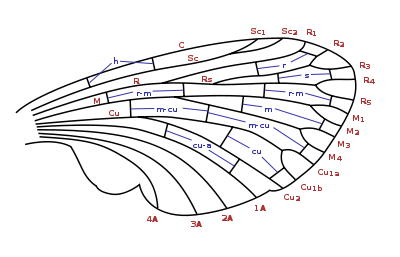Comstock-Needham system
The Comstock-Needham system is a naming system for Flügeladerung of insects , which in 1898 by John Comstock and George Needham was proposed.
Core terminology
Longitudinal veins
From the leading edge of the wing to the rear edge, the six large longitudinal veins are designated as follows:
- Costa (C),
- Subcosta (Sc),
- Radius (R),
- Median (M),
- Cubitus (Cu),
- Anal veins (A).
With the exception of the costal and anal veins, every vein can branch out. In this case the cores are counted from the closest to the furthest. For example, two branches of the subcosta would be referred to as Sc 1 and Sc 2 .
The radius usually divides once near the base, creating the R 1 at the front and the radial sector (Rs) further back. The radial sector in turn can split twice.
The median can also split twice, resulting in four branches reaching the wing edge.
According to the Comstock-Needham system, the cubitus splits once, resulting in the Cu 1 and Cu 2 veins .
The individual anal veins are named 1A, 2A, ... They are usually not ramified.
Cross veins
Cross veins connect the longitudinal veins and are named accordingly. For example, the medio-cubital transverse artery is called m-cu. Some cross arteries, such as the humeral cross artery (h) and the sectoral cross artery (s), also have their own names.
Cell terminology
The cells are named after the veins on the front. For example, the cell between Sc 2 and R 1 is referred to as Sc 2 .
In cases where two cells are separated by a transverse artery, but they have the same longitudinal artery as the leading edge, the name is preceded by a number. For example, the R 1 cell is divided into two parts by the radial cross-veins. The one closer to the base is then called the “first R 1 ”, the more distant “second R 1 ” cell.
If a cell meets a branching longitudinal artery at the front, it is named after the more distant one.
swell
- Charles A. Triplehorn, Norman F. Johnson: Borror and DeLong's introduction to the study of insects . 7th edition. Thomson Brooks / Cole, 2005, ISBN 0-03-096835-6 .
- North Carolina State University Page on Insect Wings

